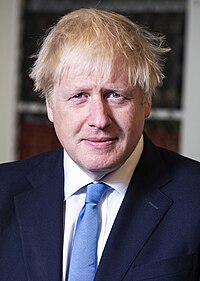
Back Kabinettsumbildung in Großbritannien 2020 German Kabinetsherschikking in het Verenigd Koninkrijk 2020 Dutch 2020年英國內閣改組 Chinese

Boris Johnson carried out the first significant reshuffle of his majority government on 13 February 2020. Following the December 2019 general election, there was considerable speculation that Johnson was planning a major reshuffle of the Cabinet, to take place after the United Kingdom's official withdrawal from the European Union on 31 January 2020. There were reports that up to a third of the Cabinet would be dismissed, Whitehall departments abolished and civil servants replaced by policy experts; however, the reshuffle was smaller than expected and no departments were abolished.[1] The anticipated reshuffle was nicknamed "The St Valentine's Day Massacre" in the press, due to its proximity to St Valentine's Day, the name being a reference to the 1929 gangland shooting in Chicago.[2][3]
Johnson formed his first ministry on 24 July 2019, following his election as Leader of the Conservative Party and subsequent appointment as Prime Minister of the United Kingdom.[4] In September 2019, he carried out small reshuffles in response to the resignations of two Cabinet ministers (Jo Johnson and Amber Rudd).[5][6] After the Conservative Party's victory in the 2019 general election, Johnson's only change had been to fill the position left vacant by Alun Cairns' resignation in the previous month.[7]
On 13 February 2020, Johnson reshuffled the government. Five Cabinet ministers were sacked, including the Northern Ireland Secretary Julian Smith, a decision that was criticised by several politicians and commentators following Smith's success in restoring the devolved Northern Ireland Executive under the terms of the New Decade, New Approach agreement.[8] Chancellor of the Exchequer Sajid Javid resigned from the Cabinet after refusing Johnson's demand that he dismiss his advisers.[9]
This was the last major cabinet reshuffle before the COVID-19 pandemic in the United Kingdom, and was followed by two more reshuffles in 2021 and 2022.
- ^ Shipman, Tim (15 December 2019). "Now for the Boris Johnson revolution — PM to wield axe in radical cabinet reshuffle". The Times.
- ^ Balls, Katy (13 January 2020). "The strategy behind Boris Johnson's incoming government shake-up". The Spectator. Archived from the original on 17 February 2020. Retrieved 13 February 2020.
- ^ Tominey, Camilla (5 February 2020). "Will Boris Johnson's post-Brexit reshuffle be a Valentine's Day massacre?". Daily Telegraph.
- ^ "Boris Johnson becomes UK's new prime minister". BBC News. 24 July 2019.
- ^ Havergal, Chris (10 September 2019). "Chris Skidmore returns as universities minister in UK government". Times Higher Education.
- ^ "Therese Coffey replaces Amber Rudd in cabinet after dramatic resignation". ITV News. 8 September 2019.
- ^ "Simon Hart appointed new Welsh secretary". BBC News. 16 December 2019.
- ^ Walker, Peter (13 February 2020). "Smith, Leadsom and McVey out as Johnson reshuffles cabinet". The Guardian.
- ^ "Cabinet reshuffle: Sajid Javid resigns as chancellor". BBC News. 13 February 2020.